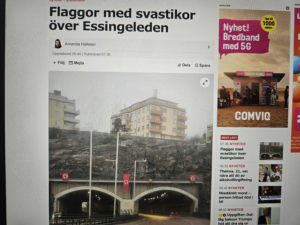By James Poulter
When the Christchurch shooter walked into a mosque and killed 51 people and injured 40 more, he was broadcasting the terrorist attack on Facebook Live. On that day in March 2019, he was not the only person with far-right beliefs using the social media platform. The following month Facebook announced it was banning a number of largely defunct far-right groups, several of which had successfully used the platform to raise money, spread their propaganda to new audiences and mobilise thousands of people for violent street protests.
Facebook is not the only social media platform who have been slow to take responsibility for the way they have let far-right activists use their tools. “Ban the Nazis” was posted on Twitter so many times it provoked a flock of articles criticising the firm. YouTube has broadcast enough Nazi video content it could have published more than the Third Reich ever managed.
One of the far-right groups banned from Facebook in April 2019 was the British National Party (BNP), which in electoral terms is the most successful British fascist organisation ever. The highpoint for the BNP came in the European elections of 2009 when it got just short of a million votes despite being attacked for being Nazis and fascists by nearly the entire media and political establishment. In the month before those elections were held, nearly 65% of the UK population visited Facebook, with only 7% accessing Twitter.
The BNP was aware of social media back in 2009. A box on the party’s website calling for supporters to “Support the [BNP] on the following Social Networking Websites. Get involved and take the message to the masses!” which was followed by links to a YouTube channel, a Facebook group, a Twitter profile, a Myspace page, a Digg account and a Flickr group for supporters to share photographs of themselves on the campaign trail with three members.
Those services were incidental to the BNP’s electoral successes. In the month they got 943,598 votes, the party had 2,577 subscribers on YouTube and only 715 followers on Twitter. The party imploded before it could really use social media effectively, but some of its former members went on to embrace the new technologies and use them in ways which have been mirrored by far-right groups around the world.
As the BNP collapsed, the English Defence League (EDL) emerged, effectively replacing the BNP as the hegemonic organisation on the British far-right. Led by former BNP member Stephen Yaxley-Lennon, known as Tommy Robinson, the EDL were prolific Facebook users. Every EDL protest would have its own Facebook event which thousands of far-right activists would be invited to attend. At the peak of the EDL, it was regularly pulling thousands of people onto the streets to violent protests against Muslims, all organised through Facebook.
Alex Roberts, presenter for anti-fascist podcast 12 Rules for What, said: “The demonstrations of the English Defence League were different in that the organisation and mobilisation took place almost entirely on Facebook – a contrast to the more traditional electoral strategies of the BNP. The mobilisation tactics of the EDL were repeated throughout the 2010s, most successfully with the Democratic Football Lads Alliance and the ‘Free Tommy’ movement.”
While drunken EDL supporters were terrorising British streets, two other former BNP members were using Facebook to spread hatred against Muslims. Former BNP councillor Paul Golding and Jim Dowson, who raised millions of pounds for the BNP, founded Britain First (BF) in May 2011. At one point BF was the most popular political organisation in Britain on Facebook, and racked up over two million followers on the platform before it was banned.
Dowson helped BF develop a sophisticated way of posting content on the platform, ahead of many other commercial and political organisations at the time. This led to BF’s content spreading outside of far-right echo-chambers and reaching new audiences.
Roberts explained: “By mixing its political messaging with more anodyne content Britain First were able to break out of their algorithmic bubble. A much larger portion of UK Facebook users were happy to share ‘Support our Troops’ memes. Solidly left wing people, and anti-fascists, started to see Britain First in their feeds – through an almost organic process.”
While BF was able to reach people outside the existing far-right, it failed to translate this into electoral successes like the BNP or well attended street protests like the EDL. Where BF was successful, was in raising money from donations. Far-right activists are now producing content for social media to make money for themselves as well as for political reasons.
One of the most successful far-right content creators of recent years was former EDL leader Stephen Yaxley-Lennon, who made a fortune from videos he posted online. When Yaxley-Lennon left the employment of hard-right Canadian YouTube channel Rebel Media and announced he was “going independent”, he received £425,000 in donations in three months. Former employees claim only 2% of this was used to produce content, the bulk of the money funding a lavish and decadent lifestyle involving cocaine and Gucci loafers.
Content Yaxley-Lennon produced played a significant role in radicalising a man who drove a van into a crowd leaving a mosque in Finsbury Park in June 2017, killing one and injuring nine others. The driver was “brainwashed” by Yaxley-Lennon’s content according to his partner and obsessively searched for it online in the days ahead of the attack.
Yaxley-Lennon’s ability to make money from being a far-right activist has been impacted by ‘de-platforming’, with social media companies finally taking responsibility for some of the content they have been publishing and removing accounts of people promoting hatred. Yaxley-Lennon was kicked off Twitter where he had over 400,000 followers and Facebook, where he had more than a million followers. YouTube allowed him to keep his account but appears to have removed it from searches and stopped recommending his videos.
Like many other far-right activists who have been banned from social media platforms, Yaxley-Lennon has migrated to Telegram and other ‘alt-tech’ platforms. On Telegram Yaxley-Lennon runs a channel which has over 150,000 followers.
Another former BNP member to use social media effectively is the BNP’s former youth leader Mark Collett. Collett has used social media accounts to build a following for himself and then launch a new fascist organisation, Patriotic Alternative (PA), which now has hundreds of supporters regularly taking part in events across the country.
Allan Jones, spokesperson for anti-fascist investigators Red Flare, said: “Collett has been producing or featuring on three or four videos a week for some time. Collett’s use of social media is noteworthy not only because of his prolific output, but for his savvy: he simultaneously tailors his content for different platforms and their respective audiences, and funnels viewers towards less regulated platforms which allow for more offensive content.”
Jones continued: “The far right has used the Internet since its very beginning. But, the emergence of social media – and particularly the influence of video-hosting platforms such as YouTube as well as its ‘alt-tech’ imitators – cannot be underestimated. Such platforms have allowed the British far-right to coalesce around a shared culture.”
The trends have been repeated around the world, particularly across Europe, where far-right groups and political parties have used social media platforms to spread their message.
Ulrike Sommer, media scientist for German anti-fascist campaign Nationalismus Ist Keine Alternative (Nationalism Is Not An Alternative, NIKA), said: “We can observe a shift from a rather old-school typical neo-Nazi aesthetic to a modernised, seemingly harmless one. This communication tactic appears especially in youth organisations like Junge Alternative (Alternative Youth. JA), the youth organisation of far-right party Alternative für Deutschland (AfD), or Identitäre Bewegung (Identitarian Movement, IB).”
One far right group to be particularly successful on German social media was the IB. On a couple of occasions campaigns they launched were reported on by Yaxley-Lennon for Rebel Media’s YouTube channel. Sommer said: “IB were able to produce pictures which showed young, modern-looking people as fighters for a white Europe without making them appear dated. They copied rather left-wing interventions in the public space, like a banner drop at the Brandenburger Tor. These kinds of public events as political practice, in combination with good photographers, video editing skills and an understanding of how images work on social media, especially Instagram and YouTube, made them very successful online and gained them a lot of public attention.”
NIKA, which focuses on far-right tendencies within German politics, specifically the AfD and European border regime, has identified a professionalisation of the communication methods used by organised far-right groups on social media platforms. Sommer explained: “They do not just use the platforms but seem to analyse how political communication can be used optimally. They present themselves not so much as organisations but as influencers, who are conservatives, who are normal young people who just want the best for their country. They do not focus on political slogans or particularly radical wording and choose to use more discrete forms of communication. Social media is a tool for them to spread and normalise a nationalist, white ethnic identity and push people to organise and vote right-wing.”
From 2015 onwards the AfD has successfully used social media to expand their voter base. They have used methods similar to those employed by Britain First while Dowson was involved earlier in the decade. Sommer added: “The AfD with its older audience were able to gain a lot of followers on Facebook very quickly. They understood that a lot of people fall for a combination of shocking images and bold statements, messages which confirm biases or suspicions they already hold. They have been producing easily shareable content. It is notable that they understood how to use specific platforms.”
This use of social media to promote far-right political parties has been replicated elsewhere in Europe. Swedish anti-fascist research magazine Garm said: “It has had a big impact, as with all tech they are early adopters and use social media to spread their views. Facebook has been a big source for the Sverigedemokraterna (Sweden Democrats) to push their agenda in both the 2014 and 2018 elections, they have by far the most interactions among the parties in Sweden.”
Popularity on social media does not always mean a party will do well in elections. Garm explained: “The extreme right-wing party Alternativ för Sverige (Alternative for Sweden – AfS) also had a high number of interactions before the election 2018, much more than many parties and they still only got 0.31% votes. The AfS party leader has more followers on his Twitter account than they got votes.”
Many far-right activists have attempted to use the coronavirus pandemic to spread their views. Safya Khan-Ruf, researcher for Hope not Hate, said: “Traditional far right messaging groups online have had a big increase in anti-vaccination and anti-lockdown posts as government measures against the virus have become politicised.
“The long-term effects of this are hard to quantify but there is certainly a danger that conspiracy theory communities online are providing new trajectories of radicalisation, especially towards more overtly antisemitic conspiracy theories.”
Khan-Ruf explained: “Though much of the European far-right has failed to exploit the pandemic as much as they hoped, it has ushered in a new age of conspiracy theories as people seek comfort in simple and monocausal explanations for a world seemingly out of control. This happens in the mainstream such as on Facebook but especially on “alternative” messaging platforms such as Telegram.”
The growth of alternative messaging apps like Telegram and other ‘alt-tech’ platforms mean far-right activists are able to organise in spaces which are harder to monitor or control, but they also restrict their audiences and make it harder for them to organise in wider society.
* James Poulter is an investigative journalist who specialises in covering the British far-right and has written for Vice UK, BBC Three, New Humanist, Huck, and The Guardian.







